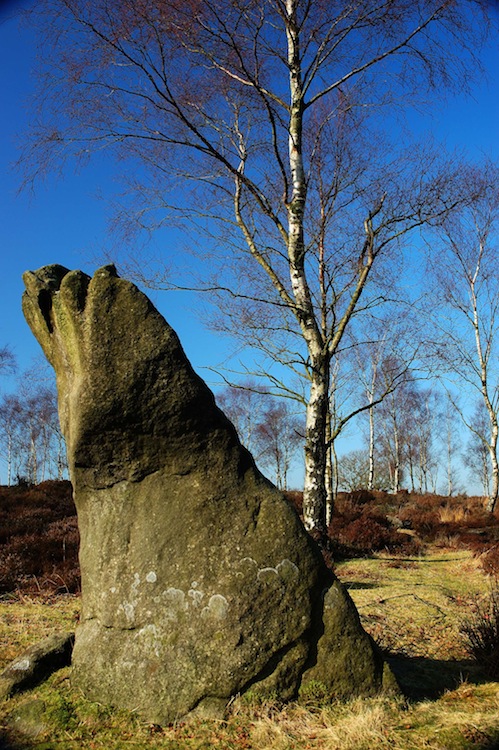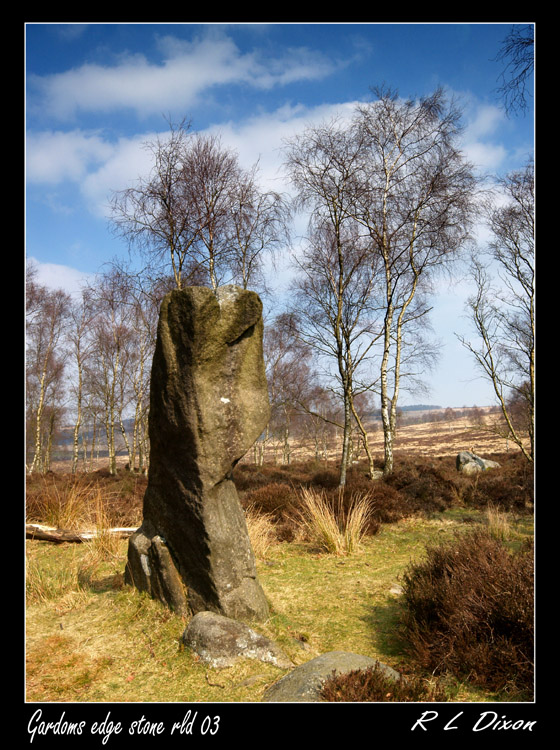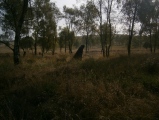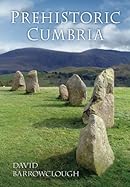<< Our Photo Pages >> Gardoms Edge Stone - Standing Stone (Menhir) in England in Derbyshire
Submitted by baz on Tuesday, 27 June 2017 Page Views: 25348
Neolithic and Bronze AgeSite Name: Gardoms Edge StoneCountry: England County: Derbyshire Type: Standing Stone (Menhir)
Nearest Town: Bakewell Nearest Village: Baslow
Map Ref: SK2725273225 Landranger Map Number: 119
Latitude: 53.255338N Longitude: 1.592979W
Condition:
| 5 | Perfect |
| 4 | Almost Perfect |
| 3 | Reasonable but with some damage |
| 2 | Ruined but still recognisable as an ancient site |
| 1 | Pretty much destroyed, possibly visible as crop marks |
| 0 | No data. |
| -1 | Completely destroyed |
| 5 | Superb |
| 4 | Good |
| 3 | Ordinary |
| 2 | Not Good |
| 1 | Awful |
| 0 | No data. |
| 5 | Can be driven to, probably with disabled access |
| 4 | Short walk on a footpath |
| 3 | Requiring a bit more of a walk |
| 2 | A long walk |
| 1 | In the middle of nowhere, a nightmare to find |
| 0 | No data. |
| 5 | co-ordinates taken by GPS or official recorded co-ordinates |
| 4 | co-ordinates scaled from a detailed map |
| 3 | co-ordinates scaled from a bad map |
| 2 | co-ordinates of the nearest village |
| 1 | co-ordinates of the nearest town |
| 0 | no data |
Internal Links:
External Links:
I have visited· I would like to visit
Couplands visited on 7th Jul 2023 - their rating: Cond: 4 Amb: 5 Access: 3
mfrincu visited on 19th Mar 2022 - their rating: Cond: 5 Amb: 4 Access: 3
elad13 visited on 2nd Dec 2018 - their rating: Cond: 4 Amb: 4 Access: 2 hwww.youtubettp.com/watch?v=_iTyCRrDNgQ - Youtube video of my recent visit
Catrinm visited on 1st Oct 2017 - their rating: Cond: 3 Amb: 4 Access: 3
dpickup69 visited on 1st Oct 2011 - their rating: Cond: 4 Amb: 4 Access: 2 This whole area is full of archaeological interest, I recommend taking a full day to explore fully. Wrap up warm!
Andy B visited #14 in our rundown of favourite standing stones (and pairs) in Britain. Gardoms Edge Stone (Derbyshire) - quite possibly a Bronze Age sundial. More of Dr Daniel Brown’s research on our pages:
drolaf Andy B rldixon TimPrevett MartinRS mark_a have visited here
Average ratings for this site from all visit loggers: Condition: 4 Ambience: 4.2 Access: 2.6

Gardom’s Edge is a striking millstone grit ridge less than an hour’s drive from Manchester. Dr Daniel Brown and researchers from Nottingham Trent University have carried out a microtopography survey of the surface surrounding the monolith. Their findings indicate the presence of packing stones around the base of the monolith, evidence that it was placed carefully in position. They have also carried out 3-D modelling of illumination of the stone through the seasons, adapting for changes in the Earth’s tilt to the ecliptic plane over four millennia. See further down this page for more details
Note: New photos of the disappearing shadow on Gardom's Edge standing stone, also see the comments for an update from Daniel Brown who has expanded his ideas into a more general appreciation of the role of shadows in skyscape archaeology
You may be viewing yesterday's version of this page. To see the most up to date information please register for a free account.
























These are just the first 25 photos of Gardoms Edge Stone. If you log in with a free user account you will be able to see our entire collection.
Do not use the above information on other web sites or publications without permission of the contributor.
Click here to see more info for this site
Nearby sites
Key: Red: member's photo, Blue: 3rd party photo, Yellow: other image, Green: no photo - please go there and take one, Grey: site destroyed
Download sites to:
KML (Google Earth)
GPX (GPS waypoints)
CSV (Garmin/Navman)
CSV (Excel)
To unlock full downloads you need to sign up as a Contributory Member. Otherwise downloads are limited to 50 sites.
Turn off the page maps and other distractions
Nearby sites listing. In the following links * = Image available
91m WSW 255° Gardoms Edge Enclosure* Causewayed Enclosure (SK2716473201)
166m ENE 63° Gardoms Edge Cairns* Barrow Cemetery (SK27407330)
191m S 170° Gardoms Edge 1* Rock Art (SK2728573037)
273m ENE 79° Gardoms Edge 02 (Baslow) Rock Art (SK27527328)
381m ENE 73° Gardoms Edge 2 (Baslow)* Rock Art (SK2761773339)
460m SSW 192° Three Men of Gardoms* Round Barrow(s) (SK2716172774)
838m S 170° Gardoms Edge Ringcairn* Ring Cairn (SK274724)
1.2km SE 125° Birchen Edge Stone* Natural Stone / Erratic / Other Natural Feature (SK28207256)
1.3km SE 131° Birchen Edge 2 Ring Cairn (SK282724)
1.3km ENE 78° Birchen Edge 1* Ring Cairn (SK285735)
1.5km WSW 254° Lady Well Wall* Holy Well or Sacred Spring (SK258728)
1.8km N 359° Swine Sty* Ancient Village or Settlement (SK272750)
1.8km SSW 195° Dobb Edge Cup and Ring* Rock Art (SK268715)
2.0km N 353° Barbrook 5* Ring Cairn (SK270752)
2.2km N 7° Big Moor* Ancient Village or Settlement (SK275754)
2.4km N 10° Barbrook Cupmarked Stone* Standing Stone (Menhir) (SK27647560)
2.4km NNE 15° Barbrook 1* Stone Circle (SK27857558)
2.5km NNE 16° Barbrook cairn* Cairn (SK27917561)
2.5km SSE 158° Gibbet Moor South* Ancient Village or Settlement (SK282709)
2.5km NNE 13° Big Moor Cairn Field* Barrow Cemetery (SK278757)
2.6km N 8° Big Moor Cairns SW* Barrow Cemetery (SK27587579)
2.6km SSE 166° Gibbet Moor 1 Cairn (SK279707)
2.6km SSE 164° Gibbet Moor 3 Cairn (SK280707)
2.6km SSE 164° Gibbet Moor 2 Cairn (SK280707)
2.6km N 11° Barbrook 2* Stone Circle (SK27757582)
View more nearby sites and additional images






 We would like to know more about this location. Please feel free to add a brief description and any relevant information in your own language.
We would like to know more about this location. Please feel free to add a brief description and any relevant information in your own language. Wir möchten mehr über diese Stätte erfahren. Bitte zögern Sie nicht, eine kurze Beschreibung und relevante Informationen in Deutsch hinzuzufügen.
Wir möchten mehr über diese Stätte erfahren. Bitte zögern Sie nicht, eine kurze Beschreibung und relevante Informationen in Deutsch hinzuzufügen. Nous aimerions en savoir encore un peu sur les lieux. S'il vous plaît n'hesitez pas à ajouter une courte description et tous les renseignements pertinents dans votre propre langue.
Nous aimerions en savoir encore un peu sur les lieux. S'il vous plaît n'hesitez pas à ajouter une courte description et tous les renseignements pertinents dans votre propre langue. Quisieramos informarnos un poco más de las lugares. No dude en añadir una breve descripción y otros datos relevantes en su propio idioma.
Quisieramos informarnos un poco más de las lugares. No dude en añadir una breve descripción y otros datos relevantes en su propio idioma.